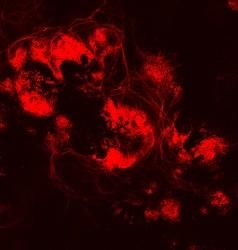Gene-editing in spiders for the first time
Offspring produce red fluorescent silk fibres
Advertisement
The University of Bayreuth’s Biomaterials research group has, for the first time, successfully applied the CRISPR-Cas9 gene-editing tool to spiders. Following the genetic modification, the spiders produced red fluorescent silk. The findings of the study have been published in the journal Angewandte Chemie.
Over the past decade, the gene-editing tool CRISPR-Cas9 has revolutionised biology. With this molecular tool, researchers can target and cut specific locations in the DNA. The cell's natural repair mechanisms can then be used either to knock out a gene or insert a new one (knock-in). Due to its efficiency, CRISPR-Cas9 has already been used in numerous studies in developmental and evolutionary biology, as well as in materials science, pest control and agriculture. “Considering the wide range of possible applications, it is surprising that there have been no studies to date using CRISPR-Cas9 in spiders,” says Professor Dr. Thomas Scheibel, Chair of Biomaterials at the University of Bayreuth and senior author of the study.
For their novel approach, Prof. Scheibel and his doctoral student Edgardo Santiago-Rivera developed an injection solution that included the components of the gene-editing system as well as a gene sequence for a red fluorescent protein. This solution was injected into the eggs of unfertilised female spiders, which were then mated with males of the same species. As a result, the offspring of the gene-edited spiders showed red fluorescence in their dragline silk – clear evidence of the successful knock-in of the gene sequence into a silk protein.
“We have demonstrated, for the first time worldwide, that CRISPR-Cas9 can be used to incorporate a desired sequence into spider silk proteins, thereby enabling the functionalisation of these silk fibres,” says Scheibel. “The ability to apply CRISPR gene-editing to spider silk is very promising for materials science research – for example, it could be used to further increase the already high tensile strength of spider silk.” The spider silk protein manipulated in this study thus serves as the first model for developing silk fibres with new properties, supporting their functionalisation for future applications.

























































